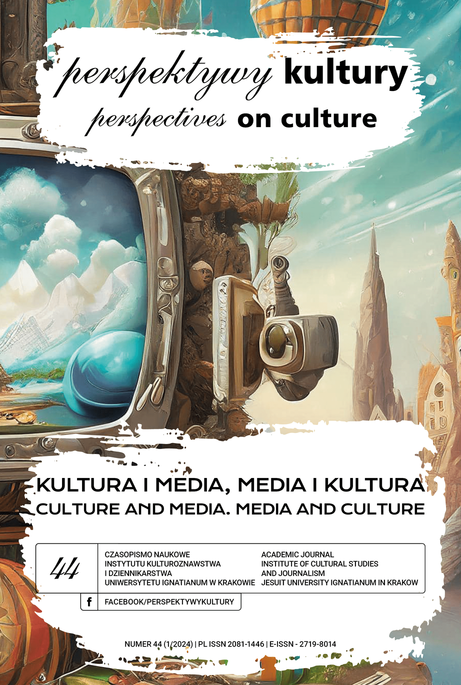The Culture of Participation versus the Media
Presentation of Exploratory Research among Young Adults
Abstract
The aim of this article is to elucidate findings from a study encompassing 284 culturally and physically active individuals, aged up to 35, who, amid the lockdown, underwent adjustments in their involvement with cultural practices. The survey facilitated the elucidation of persistent trends in perceptual consciousness alterations. Employing a quantitative research paradigm, the study utilized web survey methodology to glean declarative responses. Specifically, the lockdown precipitated a notable surge in preference for streaming services, markedly supplanting traditional cinema attendance. For instance, among 113 respondents identifying as cinema-goers, individuals who frequented cinemas at least twice a month and regarded it as a customary leisure pursuit, there was a decrease in cinema show attendance (now once a month) and a notable rise in the preference for televised content. Additionally, the study highlights the emergence of newly formed neighborhood groups as an alternative to local media, illustrating shifting social dynamics during the lockdown period. The implications of these findings extend beyond the immediate context, offering valuable insights for scholars across diverse domains, such as digital humanities, cultural studies, media pedagogy, and sociology, facilitating deeper understandings of the evolving social dynamics influenced by digital media.
References
Bańka A. (2002). Społeczna psychologia środowiskowa. Scholar: Warszawa
Baranowski M. (2019), Kultura partycypacji a nowe media: między dobrostanem a stanem złobycia. Zarządzanie w kulturze, zeszyt 1/2019, s. 1-17
Bougsiaa H., Kopciewicz L. (2016). Dzieci w kulturze mobilnej. Partycypacja, uczenie się i emancypacja pokolenia „cyfrowych tubylców”. Teraźniejszość – Człowiek – Edukacja, tom 19, numer 1(73), s. 139-154
Cieniek R. (2018). User generated content jako przejaw kultury uczestnictwa w Polsce. Kognitywistyka i Media w Edukacji , nr 1/2018
de Certeau, M. (1984). The Practice of Everyday Life. Berkeley: University of California Press
Dena C. (2008). Emerging participatory culture practices: player-created tiers in alternate reality games. Convergence 14(1):41–57
Hinton S., Hjorth, L. (2013), "What Is Web 2.0?", Understanding Social Media, SAGE Publications Ltd, pp. 7–31,
Jenkins H., Clinton K., Purushotma R.,Robison A.,Weigel M. (2009). Confronting the Challenges of Participatory Culture: Media Education for the 21st Century, https://www.macfound.org/media/article_pdfs/jenkins_white_paper.pdf (dostęp 8.09.2023)
Jupowicz-Ginalska A. (2019). Polacy a lęk przed odłączeniem – raport z badań. Warszawa
Levinson D. (1986), A conception of adult development, „American Psychologist” , vol. 41 (1/1986), s. 3–13
Nellinger N. (2016) , Participatatory culture - a handbook for students. University of Belfast
Potanievitsh T. (2015). The Concept of Luxury from a Consumer Culture Perspective. https://research.manchester.ac.uk/files/54586068/FULL_TEXT.P (dostęp 8.09.2023)
Youniar A., Barquis D. (2022) Social Media and Participatory Culture: Audience Participation and Its Contribution to Determining Video Blog Content on YouTube. Proceedings of the 2nd International Conference on Social Knowledge Sciences and Education (ICSKSE 2022). Atlantis Press
Copyright (c) 2024 Ignatianum University in Cracow

This work is licensed under a Creative Commons Attribution-NoDerivatives 4.0 International License.
Autor, zgłaszając swój artykuł, wyraża zgodę na korzystanie przez Wydawnictwo Uniwersystet Ignatianum z utworu na następujących polach eksploatacji:
- utrwalania utworu w formie papierowej, a także na nośniku cyfrowym lub magnetycznym;
- zwielokrotnienia utworu dowolną techniką, bez ograniczenia ilości wydań i liczby egzemplarzy;
- rozpowszechniania utworu i jego zwielokrotnionych egzemplarzy na jakimkolwiek nośniku, w tym wprowadzenia do obrotu, sprzedaży, użyczenia, najmu;
- wprowadzenia utworu do pamięci komputera;
- rozpowszechniania utworu w sieciach informatycznych, w tym w sieci Internet;
- publicznego wykonania, wystawienia, wyświetlenia, odtworzenia oraz nadawania i reemitowania, a także publicznego udostępniania utworu w taki sposób, aby każdy mógł mieć do niego dostęp w miejscu i czasie przez siebie wybranym.
Wydawca zobowiązuje się szanować osobiste prawa autorskie do utworu.





